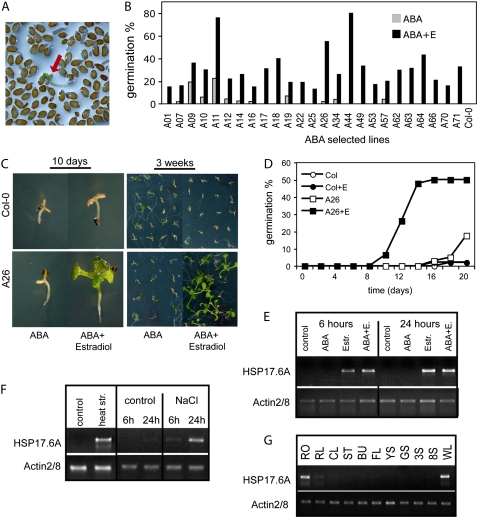Figure 3.
Identification of Arabidopsis cDNAs conferring estradiol-inducible conditional ABA insensitivity. A, Screening for ABA insensitive seed germination in the presence of 2.5 μm ABA and 4 μm estradiol. Red arrow shows a germinated seedling within the nongerminating seed population. B, Testing ABA insensitivity of 25 T2 lines. Seeds were germinated on half-strength MS medium containing 2.5 μm ABA in the presence or absence of 4 μm estradiol. Germination efficiencies were determined at day 14. C, ABA insensitivity phenotype of line A26. Seeds were germinated in the presence of 3 μm ABA in the presence or absence of 4 μm estradiol. Seedlings are shown 10 d (left) and 3 weeks (right) after germination. D, Comparison of germination efficiencies of wild-type (Col-0) and A26 seeds in the presence and absence of estradiol on ABA-containing plates. The graph shows typical germination data derived from three independent experiments. E to G, Semiquantitative RT-PCR analysis of HSP17.6A transcript levels in 2-week-old A26 seedlings using actin2/8 as standard internal reference. E, Activation of HSP17.6A transcription by 4 μm estradiol treatment with or without 50 μm ABA. F, Induction of HSP17.6A transcription with heat shock and salt stress in leaves of wild-type plants. G, Expression of HSP17.6 in different organs of wild-type Arabidopsis plants. RT-PCR analysis was performed with RNA templates prepared from roots (RO), rosette leaf (RL), cauline leaf (CL), stem (ST), unopened buds (BU), flowers (FL), young siliques (4 d after pollination; YS), developed, green siliques (10 d after pollination; GS), 3- and 8-d-old seedlings growing in vitro on solid half-strength MS medium under short day photoperiod (3S; 8S), and wilted rosette leaves (WL).

